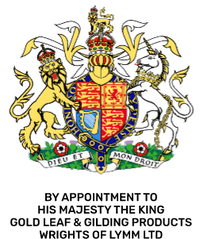The Right Brush for Every Gilding Project: Understanding Brush Types and Hair Differences
- by Sam Wozniak
The Right Brush for Every Gilding Project: Understanding Brush Types and Hair Differences
When it comes to gilding, restoration, or sign painting, the quality of your tools directly impacts the brilliance and precision of your finish. Among these tools, brushes play a critical role—especially when working with gold leaf. At Wrights of Lymm, one of the UK’s most trusted suppliers of gold leaf and gilding materials, we know that choosing the right brush is as important as selecting the gold itself. Each brush has its own personality, designed for specific purposes, techniques, and materials. Whether you are restoring a historic monument, creating a gleaming sign, or perfecting a piece of fine art, understanding brush types—and the subtle differences between natural and synthetic hairs—can make all the difference.
Understanding the Purpose: Brushes in Gilding and Sign Painting
Gilding and sign painting require a delicate balance of precision, control, and artistry. Brushes are not just tools—they are extensions of the craftsman’s hand. When applying gold leaf, a brush must pick up and release the leaf smoothly, ensuring even adhesion and a flawless surface. In restoration or monumental gilding, the brush must be capable of handling large, sometimes uneven surfaces while maintaining consistent coverage and shine.
The three main categories of brushes used in gilding and sign work are:
-
Gilding Tips
Designed for lifting and laying gold leaf. -
Gilding Mops
Designed for burnishing gold leaf. -
Signwriting Brushes
Used for painting letters, lines, and intricate designs with enamel or paint. -
Soft Dusting or Finishing Brushes
Used after gilding for cleaning, dusting, or polishing surfaces.
Each brush serves a unique role within the gilding and decorative arts process.
Types of Brushes for Gilding and Gold Leaf Application
1. Gilders’ Tips
The gilder’s tip is one of the most iconic tools in the world of gilding. These brushes are long, flat, and finely constructed to pick up and place delicate sheets of gold leaf.
Made typically from squirrel hair or badger hair, gilder’s tips are incredibly soft and responsive. The ultra-fine hairs are electrostatically charged (often by brushing them against the gilder’s face or arm) to pick up gold leaf without tearing it.
-
Squirrel Hair Tips: Renowned for their softness and precision. They allow a gilder to lift even the thinnest gold leaf and apply it seamlessly to a prepared surface.
-
Badger Hair Tips: Slightly firmer, providing more control in breezy or outdoor conditions—ideal for monumental gilding or restoration on architectural features.
Choosing between the two depends on the project’s scale and delicacy. For interior gilding or picture frame restoration, squirrel hair is often preferred. For exterior monumental projects, badger hair provides greater stability and control.
2. Gilders’ Mops
After the leaf is applied, a gilder’s mop is used to smooth, clean, or burnish the surface. Traditionally made from pony, squirrel, or soft synthetic hair, mops come in various sizes and densities.
-
Soft Hair Mops: Excellent for gently dusting away excess leaf without scratching.
-
Pony Hair Mops: Offer a slightly firmer touch for working on uneven or textured surfaces.
-
Squirrel Hair Mops: Ultra-soft and responsive—perfect for polishing and finishing high-gloss gilded areas.
A well-chosen mop can dramatically affect the sheen and finish of a goldleaf surface, ensuring the final result gleams without imperfections.
3. Signwriting Brushes
While gilding focuses on the application of leaf, sign painting demands brushes capable of producing crisp, elegant strokes. Signwriting brushes, often called quills or liners, are typically made from sable or synthetic fibres.
-
Sable Hair Brushes: Known for their spring and fine point, sable brushes hold a sharp edge and retain paint beautifully. They glide smoothly across glass, wood, or metal—making them a favourite for traditional signwriting and decorative gilding.
-
Synthetic Hair Brushes: More affordable and durable, they can mimic sable’s qualities but may lack the same fluidity. For modern enamel paints and outdoor work, synthetics can perform exceptionally well.
For gold leaf signs, artists often combine both: using a sable brush for detailed lettering and a soft mop for applying and smoothing the gold leaf overlay.
4. Burnishers and Finishing Brushes
Once the gold leaf has adhered and dried, burnishers and finishing brushes are used to achieve that signature mirror-like shine. While agate stones are used for the burnishing process itself, accompanying brushes ensure the surface is perfectly clean beforehand.
Natural-hair finishing brushes—particularly those made with soft badger or squirrel hair—remove minute particles of dust that could mar the polished surface. This final step transforms a dull gilded surface into a radiant, professional finish suitable for restoration or high-end decorative projects.
How Brush Hair Type Influences Performance
The type of hair used in a brush directly affects how it behaves during gilding or sign painting. Here’s how the most common hair types compare:
Squirrel Hair
-
Softest natural hair available
-
Ideal for delicate gold leaf work and fine finishing
-
Excellent for interior gilding, frames, and detailed designs
-
Holds and releases gold leaf evenly without tearing
Badger Hair
-
Slightly firmer with good spring
-
Best for exterior or monumental gilding where more control is needed
-
Handles larger leaf sections and uneven surfaces efficiently
-
Offers durability and resilience
Sable Hair
-
Premium quality for signwriting
-
Retains a sharp point and perfect paint flow
-
Preferred for lettering and design precision
-
Commonly used in traditional sign painting and restoration
Synthetic Fibres
-
Modern alternative to natural hair
-
More durable and weather-resistant
-
Excellent for outdoor work and water-based paints
-
Less absorption compared to natural hairs, but easy to clean and maintain
Each hair type interacts differently with gold leaf, paint, and varnish. Professionals often keep several brushes at hand—selecting the ideal one depending on surface, technique, and environmental conditions.
Choosing the Right Brush for Your Project
Selecting the right brush starts with understanding your goal:
-
For gilding on glass or fine surfaces, choose a squirrel hair gilder’s tip and soft mop for precision.
-
For monumental gilding or outdoor restoration, opt for badger hair brushes for better control.
-
For sign painting, sable hair quills remain the gold standard for crisp lettering and lasting definition.
Whether working on a delicate mirror edge, a church dome, or a traditional shop sign, investing in high-quality brushes ensures that your gold leaf is applied flawlessly and your finish lasts for years.
Caring for Your Gilding Brushes
Proper maintenance extends the life of your tools and preserves their performance:
-
Always clean brushes immediately after use—using the appropriate solvent for the material (water, turpentine, or spirit).
-
Store brushes flat or hanging to prevent bent bristles.
-
Avoid soaking natural hair brushes in water for long periods, as it can loosen the binding.
-
Keep a dust-free container for gilder’s tips to maintain static properties.
By caring for your brushes, you not only save money but ensure consistent quality in every gilding, restoration, or goldleaf project.
The Wrights of Lymm Standard
At Wrights of Lymm, we have been supplying professional gilders, restorers, and signwriters with the finest gold leaf, brushes, and materials for generations. Our selection of specialist brushes is curated to meet the highest standards of craftsmanship—whether you’re restoring historic monuments, crafting traditional signage, or adding brilliance to bespoke interiors.
We understand that true artistry lies in the details. That’s why we supply only the finest brush makers’ products, ensuring every stroke you make—whether with squirrel, badger, or sable hair—is smooth, controlled, and worthy of the gold it carries.
Final Thoughts
Choosing the right brush is not simply a technical decision—it’s a creative one. Each project, surface, and material calls for a specific touch. Understanding how brush hair type, shape, and size affect the movement of gold leaf or paint allows you to refine your technique and produce stunning, professional results.
For anyone dedicated to the timeless crafts of gilding, restoration, and sign painting, the right brush isn’t just a tool—it’s a trusted companion in every golden masterpiece.






